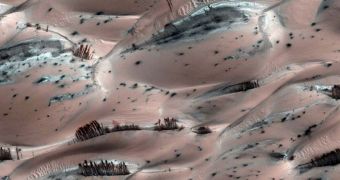In a series of new images captured by a NASA orbiter around Mars, the Red Planet reveals a number of peculiar structures on its surface, very close to the north pole. According to the experts who got a chance to look at the images, these formations can easily be identified as trees by laypersons, but they argue that this is not the case, and will never be. The images have caused quite a stir, and conspiracy theorists are already arguing that life may exist on our neighboring planet. However, astronomers and planetary scientists point out the impossibility of such a thing ever occurring, at least in the way we came to know life, Space reports.
In truth, some of the structures captured in the new photographs look remarkably like trees, but they are nothing more than optical illusions, experts say. Scientists at the University of Arizona, led by expert Candy Hansen, managed to analyze the images, and reveal that the darker structures that resemble the trees are most likely dark, basaltic sands, similar to the ones found at other locations on Mars. Given their location, the team believes, there is only one possible explanation for why they appeared. The science team at UA says that the formations were caused by frozen carbon dioxide, or dry ice, sublimating from the ground directly into vapor.
This type of process is similar to the one going on at the planet's south pole, where spider-like features form in the ground as dry ice sublimates (turns directly from solid into gas). Hansen, who is also a member of the Mars Reconnaissance Orbiter (MRO) team, adds that dunes similar to the ones in the recent images are found all around the northern Martian pole, surrounding it like a ring. The reason why these structures appear now is that spring is starting on the Red Planet. As we were also telling you about, temperatures may have also risen sufficiently to allow for the functioning of the Phoenix Mars Lander, although chances of reviving it are slim.
“What we think is happening is that the dark sand is sliding down the bright frosted portion of the dune,” Hansen says. He reveals that the new images showing the “trees” were collected with the High Resolution Imaging Science Experiment (HiRISE) camera aboard the MRO, one of the best observation instrument aboard a spacecraft today. Hansen reveals that the dark streaks in the image indeed appear to be rising, but says that this is just an optical illusion. “You're looking at the slip face of the dune, and where the sand comes to a stop, it forms a sort of scallop-shaped edge at the bottom,” he explains. “If you look closely, you can see this little dust cloud casting a tiny shadow,” the expert concludes.

 14 DAY TRIAL //
14 DAY TRIAL //